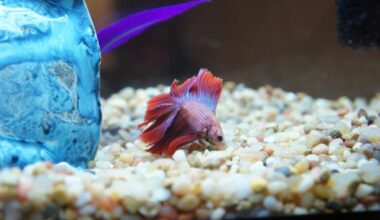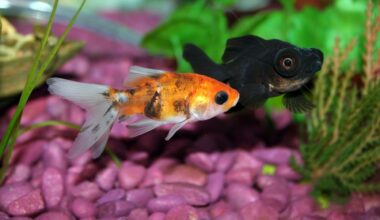Learning how to lower the pH in your aquarium is an essential skill when it comes to maintaining a healthy fish tank.
But it can seem a little intimidating at first.
You see, this isn’t knowledge that’s made readily available during the shopping process. You can run out and buy a tank with some fish, and at no part in the process will you be taught what to do.
Unfortunately, this leads to beginners getting ahead of themselves and setting up a tank they’re not prepared to maintain. All this does is make the process frustrating for them, and dangerous for their fish.
That’s where this guide comes in. It’ll teach you how to lower the pH in your aquarium using the most effective methods.
By the time you’re done reading it, you’ll be fully prepared to make adjustments to your tank when needed.
Table of Contents
Reason To Lower The pH
So when would you need to lower the pH in your fish tank anyway? Is it one of those things where high pH is bad, and low pH is good?
These are all questions we get from newer aquarists, so it’s important for us to address them before we teach you how to actually do it.
The levels of pH are simply a unit to measure how acidic or basic certain water is. The scale goes from 0 to 14 with water being less acidic the higher the number is, and a pH of 7 meaning the water is neutral.
It’s also logarithmic. That means a pH of 5 is 10 times more acidic than a pH of 6, and a pH of 4 is 100 times more acidic than 6.
Author Note: There are plenty of helpful scientific resources you can visit if you want to learn all the nitty-gritty. But for the purposes of this guide, we’re going to keep this part fairly high level.
This matters a great deal because each aquatic species has an ideal pH range for their water. For example, some fish do best with a pH of 7.5 to 8.5 and others require a range of 5.8 to 7.
Some can tolerate a wider range than others, but they all have a limit. This originates from each species’ adaptation to the water in their natural habitat, and it’s why we include recommended pH levels in all of our care guides.
If the pH level starts to climb above this required range it becomes very crucial that you lower it. Water that’s too basic will cause serious health complications such as damage to a fish’s gills.
If the pH gets too high and isn’t corrected it’s very likely to have fatal consequences. Not good.
Methods To Lower Aquarium pH
Now that we’ve freaked you out, it’s time to teach you how to lower the pH in your aquarium. We like to do this naturally when possible, but we’ve listed a variety of effective methods to give you plenty of options.
But remember this first:
It’s incredibly important to lower the pH in your fish tank gradually. As you probably know, sudden changes to water parameters can cause serious problems for all types of aquatic life.
So even if your tank has a pH level that’s way too high, slow and steady wins the race. You’re better off gradually and consistently bringing it down over the course of 48 hours than doing it all at once.
1. Add Peat Moss
One of the best ways to naturally lower the pH in a fish tank is by adding peat moss. In fact, this is our favorite method overall (which is why we put it first).

A lot of aquarists are a bit skeptical when they hear about this technique. It can’t be that easy right?
But it is.
Peat moss is acidic and high in tannins. By simply adding it to your aquarium it will begin to gradually bring the pH level down (depending on how much you add).
All you need to do is pick some up from your local garden shop or nursery and put it in your filter. Tucking it away in the filter allows the peat moss to impact the water more effectively and stay out of the way (it will float all over the place if you just drop it in your tank).
You’ll probably notice that your water will get a bit yellow after adding it. If aesthetics are important to you, just soak your peat moss somewhere else to reduce this effect (soak it in water that has parameters similar to your tank).
Author Note: The only tricky part about using peat moss is there’s no formula for how much to add. The most effective approach is to add a bit, wait, test your water, then continue to add more if your pH is still too high.
2. Include Some Driftwood
Including some driftwood is another way to lower the pH in your aquarium naturally. While we like peat moss a little more in terms of its effectiveness, driftwood still does a heck of a job!
The nice thing about relying on driftwood as a way to keep the pH level under control is that it doubles as hiding places for various fish! You’ll see that in a lot of our care guides we recommend including driftwood for this reason.
You should obviously make sure there’s room in your fish tank before adding it of course. If things are already packed a little tight then we encourage you to try another method on this list instead.
You should only consider adding aquarium-safe driftwood since other kinds are only made for terrariums or the dry portion of paludariums (aka not meant to be underwater). Those varieties are treated with chemicals that can be toxic to aquatic life.
While there are ways to take driftwood that’s not intended for fish tank use and make it safe it’s way more of a headache than it’s worth. Not only will you spend a lot of unnecessary time doing this, but there’s never a 100% guarantee that it will be completely safe.
Just save yourself the hassle and get aquarium-safe driftwood.
3. Perform Partial Water Changes
Partial water changes are another great way to keep pH levels under control. This is something that you should be doing on a consistent basis for most creatures you keep in an aquarium, but this will give you another reason to make time for it!
A partial water change is helpful because it improves the overall quality and cleanliness of the water in your tank. When you swap out a portion of the water in your tank you’re removing some of the organic waste that naturally accumulates in the tank (which leads to high ammonia levels).
Obviously you can’t change all the water at once without having another home for the life in your fish tank, so this is where a partial change comes in handy. Most of the time aiming for a 20 to 30 percent change will do the job.
This is more of a maintenance tactic than a response tactic, but that doesn’t make it any less powerful. Making sure your pH is in the proper range means it’s far less likely to rise, and way easier to lower if needed.
4. Add Catappa Leaves
This is another effective and natural way to lower the pH in any freshwater aquarium. Catappa leaves (also called Indian almond leaves) can make a big impact on the water in your tank, and life inside it.

Starting with the obvious benefit first, they can lower the pH levels. These leaves will release a bunch of tannins into your water which will make an impact on the acidity over time.
But that’s not the only thing they do.
Adding catappa leaves to your water can also protect your tank from fungal and bacterial infections! While this might seem a little too good to be true, it’s been scientifically proven.
A lot of the most experienced aquarists we know have these leaves on hand for and use them to either treat their tank directly or sprinkle in as a maintenance and prevention strategy.
With these, you don’t need to worry about stuffing them in your filter like you would with peat moss. Just crumble them up the best you can and add it directly to your tank.
Don’t go overboard with these. Add them gradually over time and test the water parameters as you go.
5. Use Reverse Osmosis
This is a trick for lowering the pH in fish tanks that many aquarists don’t know much about. That’s because it’s a bit trickier than the other methods and requires you to have specific gear.
You can’t argue with the results though!
Water created through reverse osmosis is as pure as it gets. It’s devoid of chemicals, water hardness, and it’s completely neutral when it comes to pH.
This process also removes almost all of the waste that builds up in water over time.
That means you’ll have much more consistency when it comes to water conditions, making it WAY easier to lower the pH in your fish tank. While there’s always an element of uncertainty with the natural methods on this list, using reverse osmosis gives you complete control.
Obviously, the downside is the cost. These machines aren’t cheap and will require some maintenance over the course of their lifetime. It’s a little more complex than simply adding peat moss or catappa leaves!
If you’re looking to go all-out and have a larger tank (these won’t fit nano aquariums) then reverse osmosis is a great choice. You’ll be able to lower the pH in your aquarium with ease and maintain highly stable conditions.
Make Sure You’re Getting Accurate Readings
One of the most common mistakes that new aquarists make is with the quality of their test kits. They buy an inaccurate kit that regularly gives false or incorrect readings.
This tricks them into thinking they need to lower the pH in their aquarium when they really don’t. In other words, this causes them to unknowingly injure the animals in their habitat.
Do yourself a favor and get a reliable kit so you can make well-informed decisions. Here’s the only one we recommend:
- Kit contains 800+ tests
- Monitors pH, high range pH, ammonia, nitrite, nitrate
- Helps monitor water quality and prevent invisible water problems that can be harmful to fish and cause fish loss
- Use for weekly monitoring and when water or fish problems appear
Now You’re Ready
Now that you’ve learned how to lower the pH in your aquarium there’s nothing to be afraid of!
When you peel back the curtain it becomes clear that many parts of fishkeeping are more intimidating without the proper knowledge. It’s more about being consistent and caring about the wellbeing of your fish!
While there are other methods for lowering the pH in a freshwater tank, we didn’t include them for a reason. The options we listed above are effective, powerful, and reliable.
A lot of the other less-common tactics aren’t.
We’re always open to discussing new methods and tricks for lowering pH of course (it’s how we get better and discover new tricks). But for the purposes of this guide, we wanted to stick with the classics.
If you have other methods you’ve been trying or seeing success with then we’d love for you to share them. We’re always eager to learn and would definitely consider adding anything interesting to this guide in the future!


